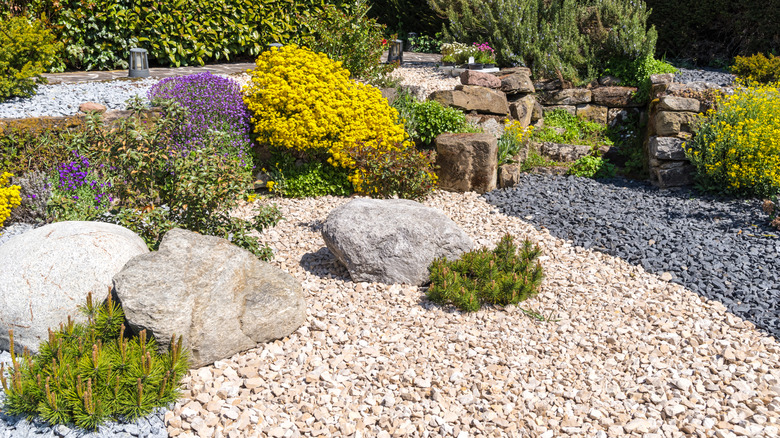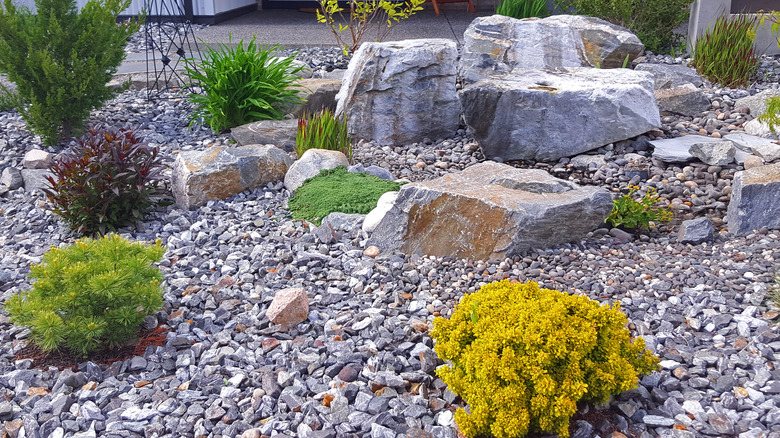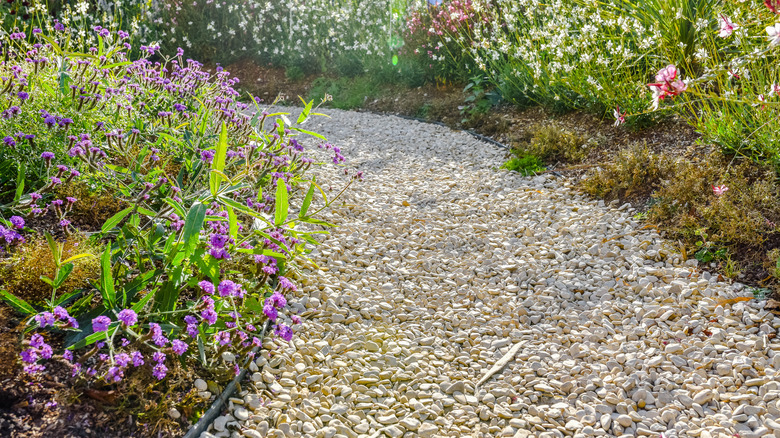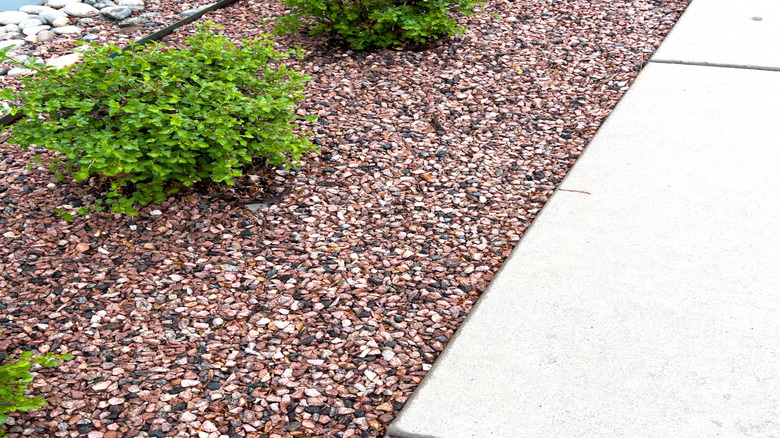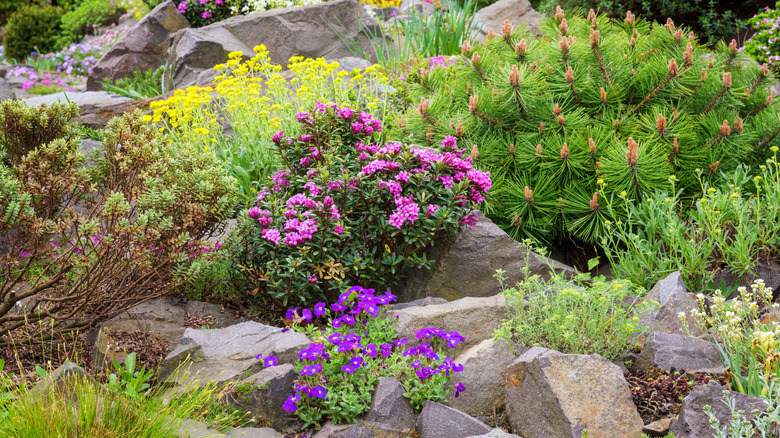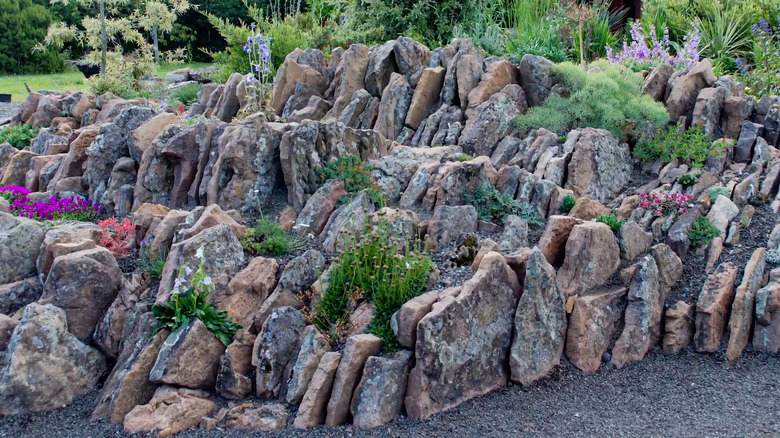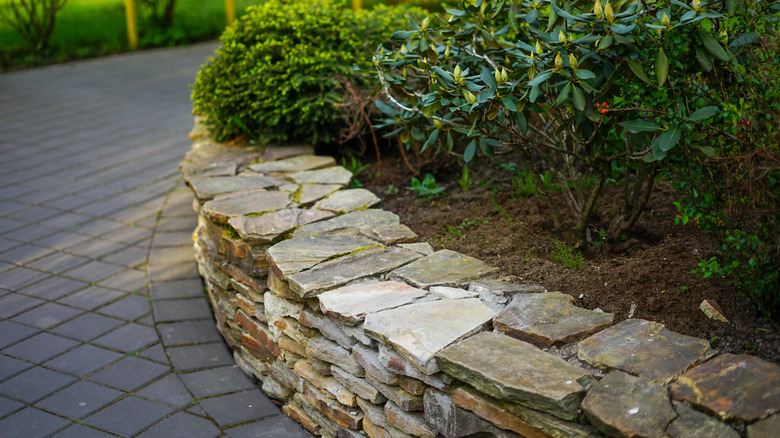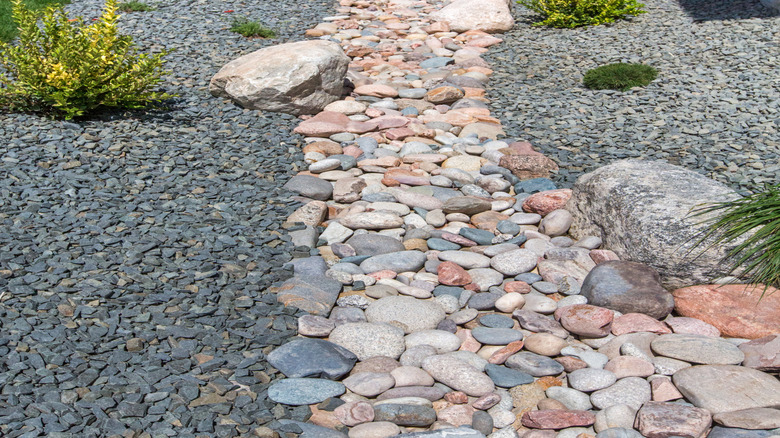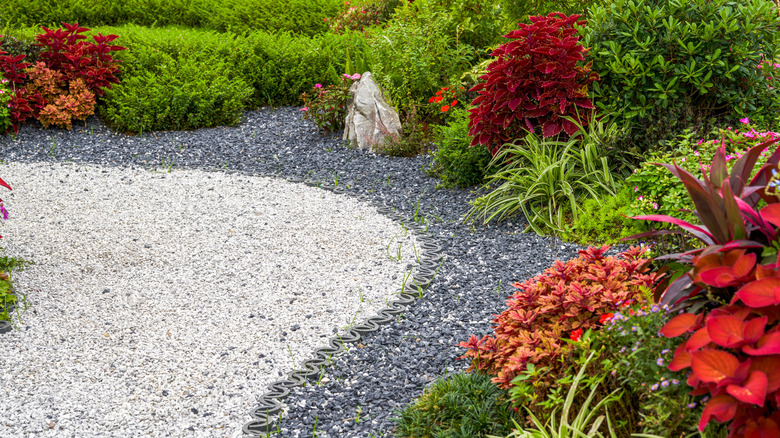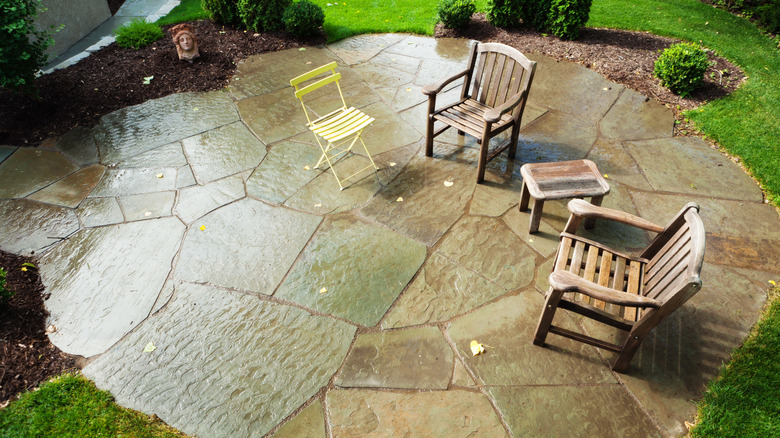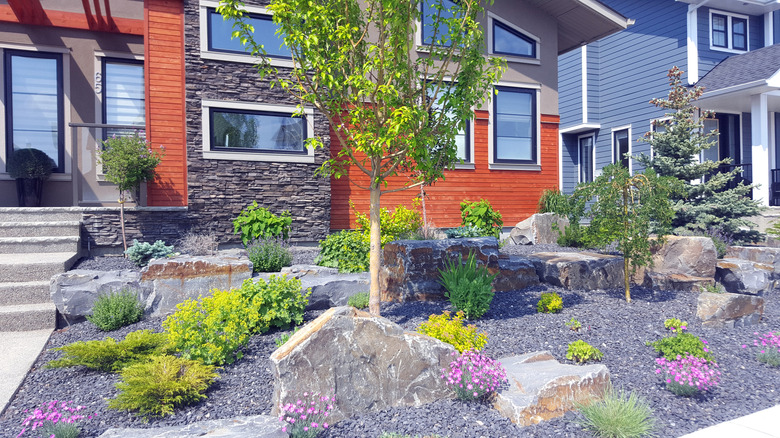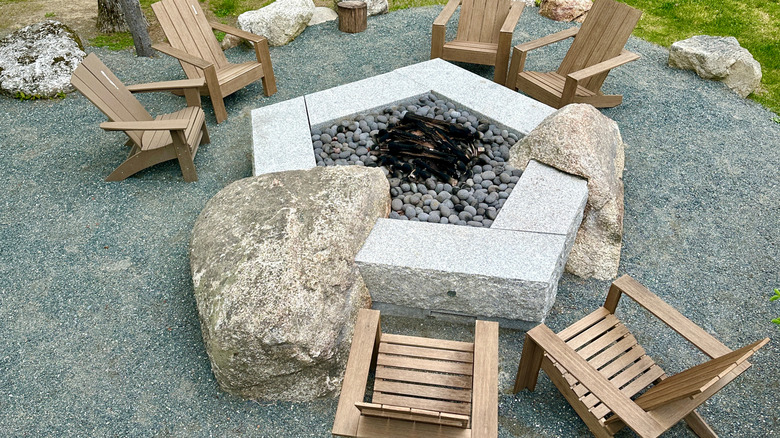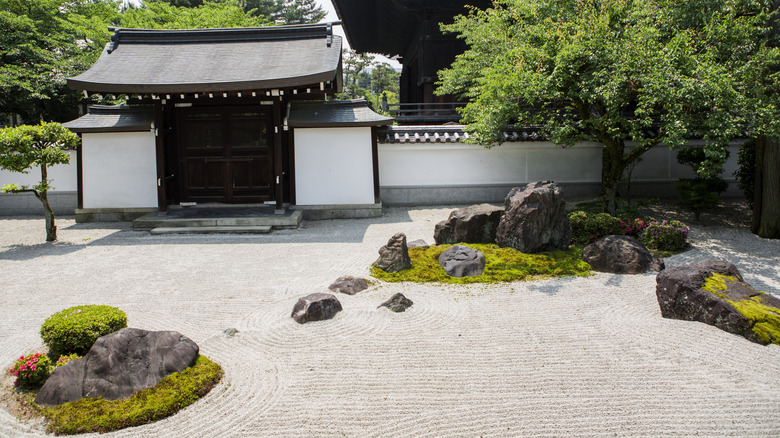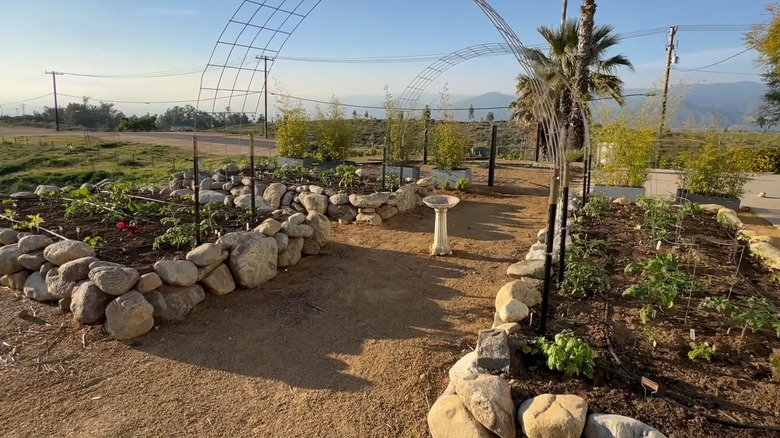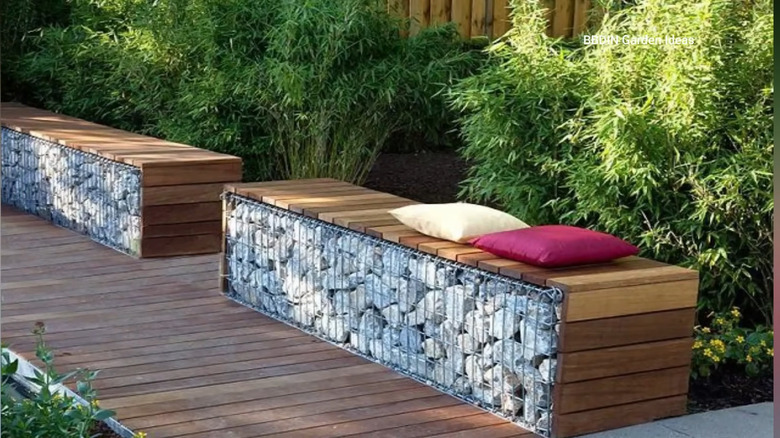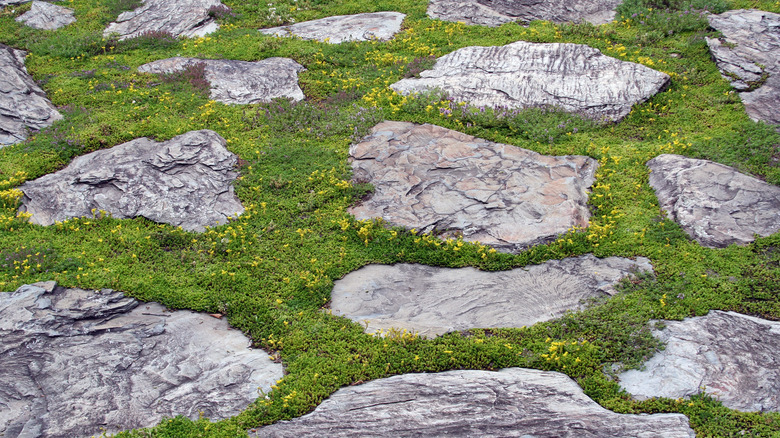15 Stone Landscaping Ideas That Require Little Upkeep And Add Charm To Your Outdoor Space
Rocks are the unsung heroes of landscaping. They don't need water, pruning, or fertilizer, and yet they continue to do the heavy lifting in beautiful landscapes all over the world. From defining pathways to framing garden beds, rocks add instant charm to your outdoor spaces without creating extra work. While there are hundreds of uses for rocks in the garden, some of them are celebrated by homeowners for being low-maintenance ways to landscape that make your life a little bit easier.
This is simply because when it comes to yards and gardens, no other material is quite as low-maintenance as rocks. They never wear out, they don't attract pests, and they help keep the soil around your home dry. Whether they are used for borders, retaining walls, or paths, rocks are durable and heavy enough to handle just about any job. From large boulder accents to small pebble designs, rocks are also highly decorative and versatile, fitting in seamlessly with any aesthetic.
With the right placement, rocks help tie in other natural elements to bring balance and texture to your landscape. If you're looking for ways to simplify yardwork and add lasting beauty to update your curb appeal, these stone landscaping ideas will help you create outdoor spaces that are both beautiful and easy to maintain.
Replace your lawn with stone landscaping
Whether you want to get rid of your lawn to help the environment or to simply make your life easier, stone landscaping is a good alternative to grass. Not only will you reduce the amount of money you spend on lawn care each year, but you can also enjoy more of your weekends without the lawn mowing chore hanging over your head. If you have children or pets, consider keeping a small patch of grass in the backyard for those regular romp and play sessions.
Use gravel for low-maintenance pathways
If parts of your lawn and garden are suffering from soil compaction due to too much traffic, consider putting in a gravel path. Gravel paths are easy to maintain, especially compared to patches of lawn that are struggling no matter how much water and fertilizer you give them. Once installed, gravel paths don't need much more than a bit of raking and light weeding. Every few years, replenishing them with gravel helps them stay looking good.
Use rock for mulch around drought-tolerant plants
While stone mulch isn't well-suited to all plants and climates because it can absorb so much heat, many drought-tolerant plants can handle and even prefer growing in stones and gravel. From sedum to lavender, certain plants are well-suited to gardens that use rock mulch. For the best results, choose light-colored rocks, especially in areas receiving direct sunlight, as they absorb less heat, and pair them with perennial, tree, and shrub varieties that are heat and drought-tolerant.
Create alpine rock gardens for year-round texture
There are a lot of different types of rock gardens, but they all have one thing in common: Rocks are a primary element. In alpine rock gardens, rocks share the stage with certain types of alpine plants. Alpine gardens are designed to simulate a high-altitude mountain garden, with plants like phlox (Phlox subulata) and lamb's ear (Stachys byzantina). These hardy, low-growing plants thrive in the rocky, well-drained soil typically used in alpine rock gardens.
Design crevice rock gardens with drought-tolerant plants
Crevice gardens are a specialized type of alpine rock garden, with flat rocks stacked at an angle with soil in between. This method originated in the Czech Republic in the mid-1980s, taking alpine gardening to the next level. Crevice gardens are becoming increasingly popular across the United States. They provide visual interest all year long, and when planted with carefully selected plants, they almost never need to be watered.
Build stone retaining walls for structure and style
The design of almost any hardscaping feature lends itself to the use of natural stone, whether it's a patio, pathway, or edging. Retaining walls, in particular, showcase how functional and aesthetically pleasing rocks can be in the landscape. Whether you use dry-stacked rocks, mortared stone, or gabion baskets, rock retaining walls have several advantages over other materials, such as durability and weight.
Install dry creek beds for natural drainage
Dry creek beds are showing up in more yards as people become increasingly aware of the effects of erosion. A dry creek bed not only looks good, but the rocks and gravel can keep soil and plants in place during periods of heavy rains or flooding. In residential locations, dry creek beds are ideal for accepting overflow from gutters and rain barrels. Erosion control measures like this can improve property values and help you avoid maintenance problems down the road.
Outline beds with pebble or river rock borders
Pebbles and river rocks come in so many shapes, colors, and sizes that there are endless styles you can achieve to outline flower beds. Whether you choose a geometric pattern or flowing curvy shapes, there are many stunning gravel garden ideas for inspiration when you're edging your paths and flower beds. Wide swaths of gravel along flower beds can replace or reduce your lawn, lowering your yard maintenance costs and freeing up some of your personal time.
Lay flagstone patios for classic outdoor living
One of the most significant advantages of flagstone is that it's naturally slip-resistant. Although more expensive than other types of patio materials, natural flagstone offers an elegant look that can't be beat. From high-end, modern landscapes to rustic cottage-core gardens, flagstone is a durable choice that adds character and charm to any outdoor space. Another perk of flagstone patios is that they are easy to care for. With regular sweepings and refilling the cracks with masonry sand now and then, they'll continue to look good for years.
Anchor your landscape with boulder accents
Boulders give permanence to your landscaping design. Often used as focal points, boulder accents create visual interest through every season. Depending on where you live and what's locally available, landscaping boulders can be expensive, but they're popular for sloped yards and naturalistic exterior designs. With their size and weight, boulders are a low-maintenance investment that instantly adds character to your landscaping.
Build a stone fire pit area for outdoor gatherings
Fire pits are as unique as snowflakes — no two are alike — but stone is a common element in outdoor fire pits. Whether it's for the pathway, the gravel pad, or a stone circle pit, stone is used in fire pit areas in multiple ways. Rocks can be used alone to create a semi-permanent fire pit or combined with concrete to create a more permanent solution. Creatively blend angles and lines with the natural shape of rocks to achieve any aesthetic.
Create zen-inspired stone gardens for a calming touch
Zen gardens are a type of stone landscaping designed to promote meditation and harmony by creating still landscapes with rocks, trees, moss, and sand. The simplicity and tranquility are what make a Zen garden different from other types of rock gardens, and they also reduce the need for upkeep. Unlike your typical busy garden, these are focused on principles like stillness and austerity. Zen gardens can be any size, but water and large plants are avoided, leaving only the quiet patterns of raked sand and the contrast of stone.
Define spaces with stone edging for garden beds
Many people find rocks placed around garden beds charming, and as far as materials for edging and raised beds go, rocks are a durable solution. If you already have fieldstones in your yard that need to go somewhere, then using rocks for borders and raised beds is also practical. Some of the benefits of stone landscaping include well-defined spaces and reduced erosion. Stones also add natural shape and texture to the garden when used as a border.
Use gabions in landscaping for a modern look
Gabions have been around for hundreds of years — much longer than most people realize. In ancient times, they were used for battlefields and flood control, while today they're frequently seen along highways to prevent erosion. Gabions are also stylish for the yard and garden, with people using them for everything from planters and retaining walls to benches and water features. If you have a yard full of river rocks, gabions can serve multiple purposes by putting the stones to good use while also helping to clear your space.
Add stepping stones through groundcover for natural paths
Stepping stones through groundcover create an aesthetic straight out of a fairy tale. It's also an option that works well for high-traffic areas. When it comes to lawn alternatives, groundcovers and stepping stones are an easy solution. Good combinations of groundcovers with stepping stones include using flagstones with Irish moss (Sagina subulata) and pavers with creeping thyme (Thymus serpyllum). Adding groundcovers to stones in your landscape softens the hard look of rocks while adding visual interest and durability to groundcover plantings.
